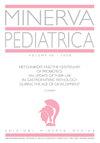Management of chronic cervical lymphadenopathy in children
IF 2.6
4区 医学
Q2 Medicine
引用次数: 1
Abstract
BACKGROUND It is important how to evaluate chronic cervical lymphadenopathies and when to perform excisional biopsy in children. We tried to analyze the usefulness of clinical and ultrasonographic findings in order to differentiate malign lymphadenopathies from benign ones. METHODS This prospective study included 100 children who had cervical lymphadenopathies, larger than 1. 5 cm for 4 weeks duration at least. Children were between 2 and 14 years old, the mean age was 6.88±3.38 years. They were examined by clinical symptoms and ultrasonographic appearances. Persistent lymphadenopathies were evaluated by excisional biopsy. RESULTS Cervical lymhadenopathies of 80 children with well clinical symptoms decreased and resolved within 10 weeks durations. Their ultrasonographic findings revealed regular margins, ovoid shapes and getting smaller than 1. 5 cm. The remaining 20 children persisting longer than 10 weeks at the same size, with worrisome clinical symptoms and susceptible ultrasonographic findings (round shapes, irregular margins) underwent excisional biopsy. According to the biopsy results, five had tubercular lymphadenopathies, three had Hodgkin'slenfoma, two had acute lymphoblastic leukemia. CONCLUSIONS Chronic cervical lymphadenopathies can persist up to 10 weeks, althoughthey are reactive and benign.儿童慢性颈部淋巴结病的治疗
背景如何评估慢性颈部淋巴结病以及何时对儿童进行切除活组织检查具有重要意义。我们试图分析临床和超声检查结果的有用性,以区分恶性淋巴结病和良性淋巴结病。方法这项前瞻性研究包括100名患有颈部淋巴结病的儿童。5cm,至少4周。儿童年龄在2至14岁之间,平均年龄为6.88±3.38岁。通过临床症状和声像图检查。通过切除活组织检查评估持续性淋巴结病。结果80例临床症状良好的儿童宫颈淋巴结病在10周内症状减轻并得到缓解。他们的超声检查结果显示边缘规则,卵圆形,并且越来越小。5厘米。其余20名儿童在相同大小下持续超过10周,有令人担忧的临床症状和易感的超声检查结果(圆形,边缘不规则),接受了切除活组织检查。根据活检结果,5例患有结节性淋巴结病,3例患有霍奇金淋巴瘤,2例患有急性淋巴细胞白血病。结论慢性颈部淋巴结病可以持续10周,尽管它们是反应性的和良性的。
本文章由计算机程序翻译,如有差异,请以英文原文为准。
求助全文
约1分钟内获得全文
求助全文
来源期刊

Minerva pediatrica
PEDIATRICS-
CiteScore
2.70
自引率
3.80%
发文量
1
审稿时长
>12 weeks
期刊介绍:
Minerva Pediatrica publishes scientific papers on pediatrics, neonatology, adolescent medicine, child and adolescent psychiatry and pediatric surgery. Manuscripts may be submitted in the form of editorials, original articles, review articles, special articles, letters to the Editor and guidelines. The journal aims to provide its readers with papers of the highest quality and impact through a process of careful peer review and editorial work.
 求助内容:
求助内容: 应助结果提醒方式:
应助结果提醒方式:


